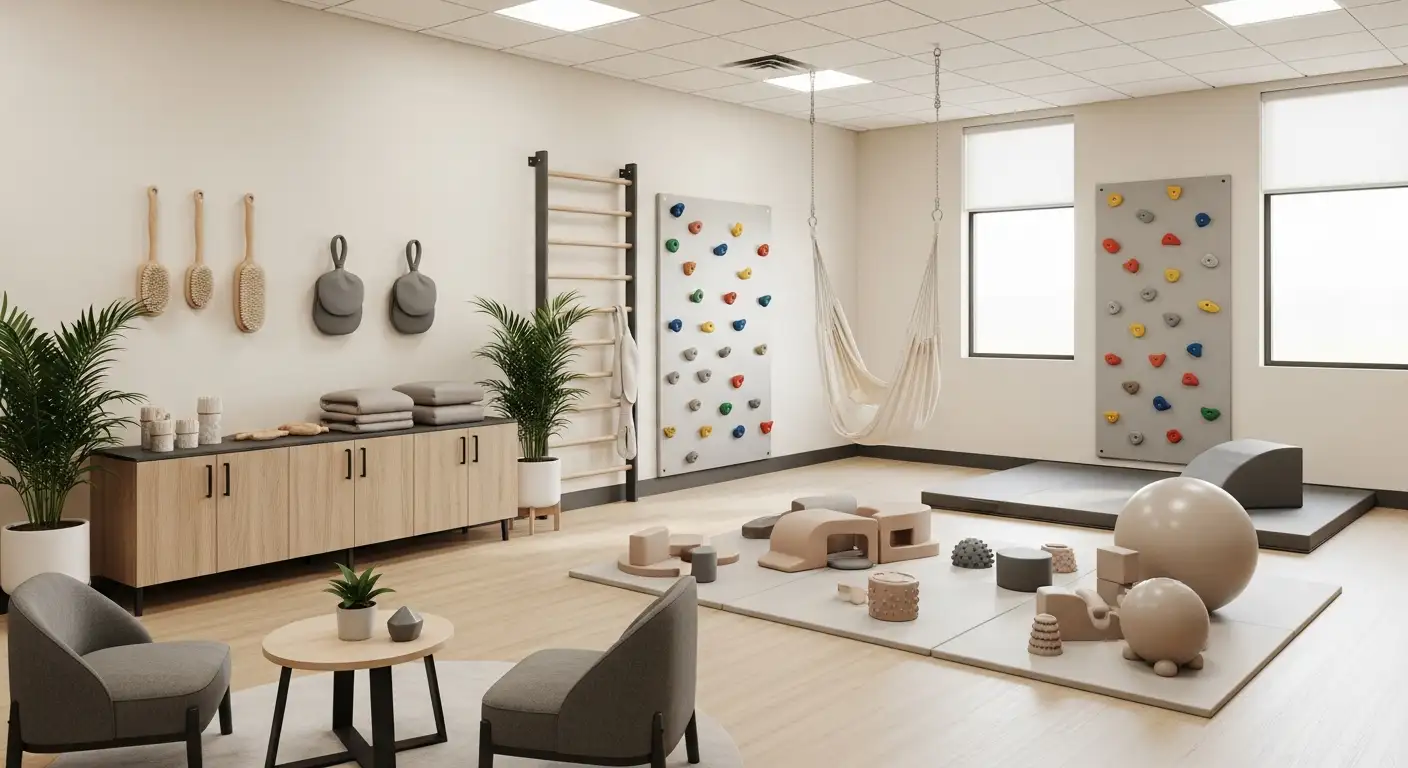Sensory Integration Therapy & Autism


Exploring Sensory Integration Therapy and Its Impact on Autism Spectrum Disorder
Sensory Integration Therapy (SIT) has emerged as an important intervention within the broader spectrum of therapies designed to support individuals with autism spectrum disorder (ASD). Grounded in the work of occupational therapists, SIT targets sensory processing challenges that frequently affect children with autism, aiming to improve their daily functioning, social interactions, and behavioral responses. This article delves into the origins, application, benefits, and controversies surrounding sensory integration therapy in the context of autism, providing a comprehensive overview of its role and relevance today.
Origins and Foundations of Sensory Integration Therapy
History of sensory integration therapy
Sensory integration therapy (SIT) originated from the pioneering work of A. Jean Ayres during the 1950s and 1960s. Ayres, an occupational therapist and educational psychologist, formally developed and introduced this approach in the late 1970s. Her research established a foundation for understanding sensory integration as a critical process affecting behavior and development.
Role of A. Jean Ayres
Ayres is recognized as the founder of sensory integration therapy. She defined sensory integration as the brain’s ability to organize and interpret sensory stimuli from the environment, enabling appropriate behavioral and functional responses. Her theory emphasized that dysfunctions in this process could significantly impact motor skills, learning, and emotional regulation.
Core principles of sensory integration
The therapy focuses on integrating multiple sensory inputs—particularly tactile (touch), vestibular (balance and movement), and proprioceptive (body awareness) systems—which are essential for everyday functioning. By targeting these systems through structured activities, SIT helps individuals, especially children, develop improved sensory processing and adaptive responses.
Neurobiological basis of sensory integration
Sensory integration is rooted in neurobiological processes where different sensory signals are coordinated in the brain for a cohesive perception of the environment. Proper integration supports motor planning, attention, and emotional regulation. Dysfunction in these neural pathways, referred to as sensory integrative dysfunction, can interfere with development and behavior, as addressed by SIT interventions.
Sensory Processing Challenges in Autism Spectrum Disorder
How common are sensory processing issues in ASD?
Sensory processing difficulties are highly prevalent among children with autism spectrum disorder (ASD), with studies indicating that approximately 90% of individuals with ASD experience some form of sensory deficit. These sensory challenges are recognized as one of the core symptomatic features associated with autism.
What types of sensory dysfunction occur?
Sensory integration dysfunction in ASD predominantly affects three critical sensory systems:
Tactile System: This involves touch sensitivity. Dysfunctions here can lead to hypersensitivity, causing withdrawal from touch, refusal to wear certain textures of clothing, or avoidance of activities like getting hands dirty.
Vestibular System: This system governs balance and spatial orientation. Dysfunction might present as either hypersensitivity—with fear of movement activities like swinging—and hyposensitivity—which can result in seeking intense sensory experiences excessively.
Proprioceptive System: This relates to awareness of body position and movement. Problems in this area often result in clumsiness, poor body awareness, resistance to motor activities, and trouble planning movements.
What are the behavioral manifestations?
Behaviorally, sensory integration dysfunction can manifest as withdrawal from sensory stimuli or, conversely, excessive seeking of sensory input. Children might display increased irritability, anxiety, difficulty focusing, or even self-harming behaviors related to unmanaged sensory overload or deprivation.
How do sensory issues affect daily life?
Sensory processing challenges impact many aspects of daily living. For instance, tactile sensitivity may interfere with dressing or eating, vestibular difficulties can limit participation in playground activities, and proprioceptive problems might hinder motor skills and coordination. These challenges can affect social interactions, communication, and the ability to engage in routine activities, thereby affecting overall quality of life and independence.
The Framework and Techniques of Sensory Integration Therapy

Assessment and Evaluation by Occupational Therapists
Sensory integration therapy begins with a thorough assessment conducted by a trained occupational therapist. This evaluation focuses on identifying how a child's nervous system processes sensory information, highlighting issues in tactile, vestibular, and proprioceptive systems. Through observation and standardized measures, therapists develop individualized plans tailored to each child's unique sensory processing needs.
Common Sensory Integration Therapy Activities
Therapy sessions use targeted activities designed to stimulate and regulate sensory systems. Typical activities include swinging, spinning, and bouncing, which provide vestibular and proprioceptive input crucial for balance and body awareness. Deep-pressure techniques, such as the Wilbarger brushing protocol, involve gently brushing the skin with a soft brush to calm sensory responses. Weighted vests and blankets offer proprioceptive feedback to promote relaxation and focus.
Use of Sensory Gyms and Sensory Diets
Sensory gyms are specialized environments equipped with tools like swings, trampolines, ball pits, and squeeze machines to provide a variety of sensory experiences in a safe, playful setting. Additionally, therapists often design a 'sensory diet'—a personalized schedule of sensory activities integrated into daily routines at home and school. This approach helps maintain sensory regulation beyond therapy sessions, supporting continuous progress in sensory processing.
Roles of Occupational and Physical Therapists
Occupational therapists lead sensory integration therapy by assessing sensory processing difficulties, creating individualized intervention plans, and guiding sensory activities to enhance daily functioning, social skills, and self-care. Physical therapists may also be involved, focusing on improving motor skills using sensory-rich exercises and working collaboratively with occupational therapists to support movement, coordination, and sensory regulation.
These combined strategies form the foundation of sensory integration therapy, aiming to help children better navigate and respond to their complex sensory environments.
Therapeutic Benefits and Outcomes for Children with Autism
What improvements can sensory integration therapy bring to children with autism?
Sensory integration therapy has been shown to produce notable improvements in several vital areas for children with autism. Research using the Autism Behavior Checklist (ABC), a validated tool, demonstrated significant reductions in scores relating to sensory processing, relationship-building, language, and social/self-care domains after just 5 to 10 therapy sessions. These improvements suggest enhanced abilities in managing sensory inputs and engaging more effectively in social and communicative activities.
How does the therapy enhance emotional regulation and motor skills?
Beyond sensory and social areas, sensory integration therapy also supports better emotional regulation and motor skills. Activities like swinging, bouncing, and climbing provide vestibular and proprioceptive input that can improve coordination and body awareness. Children often exhibit improved emotional responses, such as reduced tantrums and better focus, likely linked to enhanced sensory regulation.
What outcomes do parents and therapists report?
Parents and therapists frequently report positive behavioral and social outcomes from sensory integration therapy. Many families note benefits such as improved sleep patterns, decreased instances of self-harming behaviors, and greater ease with daily routines. These anecdotal reports align with clinical observations, highlighting improvements in a child's ability to cope with sensory challenges and participate more fully in social and self-care activities.
What evidence supports these therapeutic outcomes?
A study involving 40 children aged 3 to 9 with autism showed significant reductions in Autism Behavior Checklist scores following sensory integration occupational therapy. The therapy—administered by trained occupational therapists—included tailored activities designed to stimulate sensory responses, particularly balance and movement. These findings underscore the potential of sensory integration therapy to positively impact children’s sensory processing and related domains.
| Domain | Description | Reported Benefit |
|---|---|---|
| Sensory | Processing tactile, vestibular, proprioceptive input | Improved sensory regulation and reactivity |
| Relationship-Building | Social interaction and bonding | Enhanced social engagement and communication |
| Language | Communication skills including speech and gestures | Improved understanding and expression |
| Social/Self-Care | Daily living skills and behavioral responses | Better independence and reduced challenging behaviors |
Overall, sensory integration therapy provides a multidimensional approach that supports children's developmental needs, especially in those with autism spectrum disorder.
Integration of Sensory Integration Therapy within Comprehensive Autism Treatment

How Does Sensory Integration Therapy Relate to Other Autism Therapies?
Sensory Integration Therapy (SIT) works alongside other well-established approaches such as Applied Behavior Analysis (ABA), speech therapy, and occupational therapy to support children with autism.
ABA primarily focuses on encouraging positive behaviors and reducing negative ones through structured teaching styles like Discrete Trial Training (DTT) and Pivotal Response Training (PRT). Speech therapy targets communication skills using spoken language, signs, and adaptive devices. Meanwhile, occupational therapy covers independence skills like dressing and eating, often incorporating SIT to enhance sensory processing.
What Role Does SIT Play in Enhancing Independence and Social Skills?
By targeting challenges related to tactile, vestibular, and proprioceptive processing, SIT helps children better manage sensory inputs that can affect daily functions and social interactions. Improved sensory integration can reduce avoidance behaviors and promote comfort in physical and social environments, enabling progress in self-care and social participation.
How Do Multidisciplinary Teams Use SIT?
Occupational therapists and physiotherapists trained in SIT design personalized programs based on thorough assessments. These programs often include play-based activities such as swinging, spinning, and deep pressure techniques. Collaboration with speech therapists, behavioral therapists, and families ensures consistent support across settings—home, school, and therapy clinics.
How Does SIT Complement Developmental and Behavioral Therapies?
SIT addresses the foundational sensory-processing hurdles that can interfere with learning and behavior. When combined with behavioral approaches like ABA and developmental therapies such as speech and language therapy, children receive comprehensive support. Sensory regulation gained through SIT facilitates better engagement in communication activities, behavior modification sessions, and functional skill development.
This integrated approach creates a more effective framework for improving overall outcomes for children with autism by addressing sensory needs alongside behavioral and developmental goals.
Controversies and Current Research on Sensory Integration Therapy

Limitations and variability of scientific evidence
Sensory integration therapy (SIT) is widely used for children with sensory processing difficulties, especially those on the autism spectrum. However, the scientific evidence supporting its effectiveness is inconsistent. Some studies show promising improvements in areas like behavior, social skills, and emotional regulation, while others fail to find significant benefits. The quality of research varies, with many studies having small sample sizes or lacking rigorous controls, making it difficult to draw definitive conclusions about SIT’s efficacy.
Concerns about potential negative effects
While many families report positive outcomes, some research highlights possible negative effects of SIT. Notably, certain studies have observed increases in self-harming behaviors following therapy in some children. This raises concerns about the need for careful monitoring and individualized approaches, ensuring that treatment plans are tailored and adjusted based on each child's unique responses.
Skepticism regarding claims of 'brain rewiring'
A controversial aspect of sensory integration therapy is the claim that it can ‘rewire’ brain pathways to improve sensory processing. Many experts remain skeptical of this assertion, pointing out that there is limited scientific evidence to support such neurobiological changes as a direct result of SIT. The concept remains more theoretical than proven, necessitating cautious communication to families about what therapy can realistically achieve.
Need for more high-quality studies
Overall, there is a clear need for further high-quality, large-scale research to better understand the effectiveness and potential risks of sensory integration therapy. Future studies with rigorous designs and standardized outcome measures will help clarify its role in managing sensory difficulties, guiding therapists and families toward evidence-based practices.
Training, Access, and Resources for Sensory Integration Therapy

Qualifications of Therapists Delivering SIT
Sensory integration therapy (SIT) is primarily provided by trained occupational therapists and physiotherapists. These professionals often hold specialized training in sensory integration techniques, enabling them to assess and create individualized intervention plans tailored to each child's sensory processing needs. Their expertise ensures the use of evidence-informed methods and safe application of therapy strategies.
Finding Qualified Providers Through Professional Organizations
Families seeking sensory integration therapy can locate qualified therapists by consulting professional organizations dedicated to occupational therapy and sensory integration practice. These organizations provide directories of certified specialists, ensuring that the providers have met specific educational and clinical experience standards in SIT.
Parent Training Protocols and Home-Based Routines
A vital component of effective sensory integration therapy involves educating parents on sensory strategies. For example, the Wilbarger protocol teaches caregivers to use gentle brushing on a child's skin to promote deep pressure input, which can help regulate sensory responses. Additionally, therapists often help families design a personalized 'sensory diet'—a structured schedule of sensory activities integrated into daily routines at home or school—to reinforce therapy gains.
Use of Specialized Equipment and Sensory Tools
Sensory gyms equipped with tools such as swings, weighted vests, ball pits, trampolines, and squeeze machines play a significant role in SIT. These tools provide vestibular and proprioceptive input through activities like swinging, spinning, and bouncing. Therapists also incorporate tactile stimulation, deep pressure techniques, and therapeutic listening programs that utilize audio devices to enhance sensory processing. These resources create engaging environments conducive to sensory regulation and improved behavior.
Sensory Integration Therapy Beyond Autism
Applications in Conditions Like ADHD, Developmental Delays, and Cerebral Palsy
Sensory integration therapy (SIT) is not exclusively used for autism spectrum disorder but extends its benefits to a variety of developmental and behavioral conditions. Children with Attention Deficit Hyperactivity Disorder (ADHD), developmental delays, cerebral palsy, and other neurological or behavioral disorders can experience sensory processing dysfunctions that SIT aims to address. These dysfunctions often involve difficulties in interpreting tactile, vestibular, and proprioceptive cues essential for everyday functioning.
Sensory Integrative Dysfunction Across Developmental and Behavioral Disorders
Sensory integrative dysfunction can lead to hypersensitivity or hyposensitivity to sensory inputs, which manifests in behaviors like avoidance of touch, clumsiness, difficulty with motor planning, or seeking intense sensory experiences. Such challenges are seen across a range of conditions including learning disabilities, developmental coordination disorder, intellectual disabilities, and anxiety disorders. By recognizing sensory integration as a neurobiological process affecting diverse developmental profiles, SIT offers a comprehensive approach to improve sensory processing and associated behaviors.
Therapeutic Goals for Diverse Patient Groups
The therapy focuses on enhancing sensory regulation, improving motor skills, and fostering better social and emotional responses. For children with cerebral palsy, SIT can support improved body awareness and coordination, whereas for those with ADHD and developmental delays, the therapy helps reduce sensory overload and enhances attention and self-regulation. The overall goals include promoting independence in daily activities, reducing maladaptive behaviors, and supporting skill development tailored to individual needs. Occupational and physical therapists collaborate closely with families to create personalized intervention plans that integrate play-based sensory activities and environmental modifications for optimal outcomes.
Future Directions and Recommendations for Families and Practitioners

Importance of Accurate Diagnosis and Individualized Treatment Plans
Accurate identification of sensory processing difficulties, distinguishing them from autism spectrum disorder (ASD), ADHD, or other developmental conditions, plays a crucial role in designing effective interventions. Individualized treatment plans crafted by occupational and physical therapists ensure therapies address specific sensory needs, improving outcomes in areas such as motor skills, social interaction, and emotional regulation.
Consultation with Healthcare Providers for Comprehensive Care
Families are encouraged to work closely with healthcare professionals experienced in sensory integration therapy and ASD treatments. Collaboration among occupational therapists, pediatricians, speech therapists, and psychologists supports comprehensive care, addressing core symptoms as well as co-occurring conditions such as anxiety or motor delays.
Balancing Complementary and Traditional Treatments
While sensory integration therapy can offer meaningful benefits, it is important to balance it with evidence-based approaches like applied behavior analysis (ABA) and speech therapy. Families using complementary methods, such as special diets or mindfulness, should communicate openly with their healthcare providers to ensure safety and effectiveness within an integrated treatment plan.
Ongoing Assessment and Therapy Adjustments
Sensory needs and responses can change over time, necessitating continual evaluation by therapists. Regular monitoring allows for modifications to therapy activities, ensuring the child's progress in sensory processing, self-regulation, and functional skills is optimized. Incorporating family feedback into therapy adjustments also promotes a supportive home environment.
By prioritizing accurate diagnosis, professional consultation, thoughtful integration of therapies, and ongoing assessment, families and practitioners can foster positive developmental trajectories and enhance quality of life for individuals with sensory processing challenges and ASD.
Connecting the Dots: Sensory Integration Therapy's Place in Autism Care
Sensory integration therapy represents a vital piece of the complex autism treatment puzzle, offering specialized support for children grappling with sensory processing difficulties. While positive outcomes have been noted in several behavioral and developmental domains, it remains essential for families and practitioners to approach SIT with an informed, evidence-based perspective. Collaborative, multidisciplinary care — combining SIT with proven therapies like ABA and speech therapy — holds the greatest promise for improving quality of life for individuals with autism. Continued research, professional training, and thoughtful integration into personalized treatment strategies will further refine the understanding and impact of sensory integration therapy in the years to come.
References
- Sensory integration therapy & autism
- Treatment and Intervention for Autism Spectrum Disorder
- Sensory Integration in Autism Spectrum Disorders
- Evaluating the Benefits of Occupational Therapy in Children ...
- Treating Sensory Processing Issues
- Sensory Integration Therapy in Paediatric Rehabilitation
- The Benefits and Strategies of Sensory Integration Therapy
Recent articles

Examples of Aba Therapy for Autism
Unlocking Autism Solutions: Practical ABA Strategies Explored

The Benefits of ABA Therapy for Children with Developmental Delays
Unlocking Potential: How ABA Therapy Transforms Lives of Children with Developmental Challenges

Physical Therapy Approaches for Treating Cerebral Palsy
Innovative Strategies in Cerebral Palsy Rehabilitation

The Benefits of Occupational Therapy for Enhancing Play and Leisure Skills
Unlocking Potential Through Play: How Occupational Therapy Transforms Lives

Autism Apps For Children
Harnessing Technology to Support Children with Autism

How ABA Therapy Teaches Coping Skills for Anxiety
Building Emotional Resilience in Autism Through ABA Approaches


